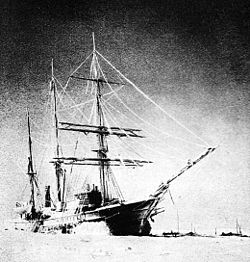Nikolai Kolomeitsev

Nikolai Nikolaevich Kolomeitsev, also spelt Kolomeytsev (Template:Lang-ru) (16 July 1867 (probably) in Saint Petersburg - 1944 in Paris) was a Russian naval officer and explorer of the Arctic. He was a member of the Chief Hydrographic Administration’s Survey Expedition to the White Sea. He had also taken part in an expedition to the Yenisei Gulf led by L. Dobrotvorskiy.
In 1900, Baron Eduard Toll led an expedition on behalf of the Russian Academy of Sciences on ship Zarya. Kolomeitsev was named commander of the ship during the expedition. His second-in-command was Fyodor Andreyevich Matisen, who had taken part in an expedition to Svalbard. Alexander Kolchak also accompanied the expedition as third naval officer and hydrographer. All these officers were from military background.
The expedition was known as The Russian Polar Expedition. Its aim was to explore well the area north of the New Siberian Islands and eventually sail towards the Pole in order to find the elusive Sannikov Land.
Kolomeitsev supervised the fitting out of the Zarya in Larvik, Norway. The expedition sailed from Saint Petersburg on 7 July 1900. Soon there was friction between Toll and Kolomeitsev concerning the treatment of the crew. Kolomeitsev, as a classic naval officer of the Russian Imperial Navy tried to keep a distance with the men and to impose harsh punishments for unruly behavior. But Toll (more in line with the spirit of the times in Russia) longed for comradeship, and treated the common sailors as equals. Therefore both men were getting into each other's nerves. Kolomeitsev interpreted Toll's attitude as an undermining of his authority as commander of the ship.[1]
The situation became worse during the first wintering in a bay just southwest of Taymyr Island. (Toll named the bay "Bukhta Kolin Archera", after Colin Archer Shipyard where Zarya had been fitted). Owing to the claustrophobic conditions of the wintering period, the relationship between captain Kolomeitsev and expedition leader Eduard Toll reached the breaking point.
Toll finally resorted to an unusual procedure; he sent Kolomeitsev on a long sledge trip along with Cossack officer Rastorguyev with the mission of organizing coal depots for the Zarya on Kotelny Island and Dikson, as well as to bring the mail of the expedition to Dudinka. After Kolomeitsev had been relieved of his duties, Fyodor Matisen was promoted as commander of Zarya. Toll could not hide his relief at seeing Kolomeitsev depart.[2]
Years later, Baroness Emmy von Toll, Eduard Toll's widow, played down the fact that there were strong disagreements between "old school" Captain Kolomeitsev and her egalitarian-minded husband. When editing her husband's journal she stated: "Further, I have omitted as non-essential the details of the mutual relations between expedition members."[2]
Apparently, Kolomeitsev was one of the few supporters of Imperial Russia in the expedition. During the last part of the journey, in the New Siberian Islands, Captain Matisen hoisted the flag of the Neva Yacht Club (Nevskiy Flot), instead of the Russian flag, on Zarya's mast. That flag flew over Zarya until it was sunk.[3]
Kolomeitsev wrote two books about his journey with the Russian Polar Expedition; one of them was published in 1901 by the Imperial Naval Academy (Izvestiya Imperatorskoy Akademii Nauk) and the other in 1902 by the Imperial Geographical Society (Izvestiya Imperatorskago Russkago Geographicheskago Obschestva).
A few years later Kolomeitsev was named captain of the torpedo boat Buinyi and saw action during the Russo-Japanese War. He became a hero during the battle of Tsushima when he brought his boat alongside the burning flagship Knyaz Suvorov. He rescued Admiral Zinovi Petrovich Rozhestvenski, wounded in the head by a shell from the burning and sinking battleship, as well as part of the crew. Admiral Rozhestvenski was transferred to cruiser Dmitri Donskoi that was eventually captured and sunk.[4] Kolomeitsev's boat was one of the only three vessels that returned to Vladivostok after the Tsushima battle.
In 1911 Kolomeitsev was promoted to the Rank of Admiral. He went into exile with his wife after the 1917 Revolution and died in France.
Posthumous honors
Since he was a war hero, Nikolai Kolomeitsev was also honored by the USSR regime. A small group of islands, a bay in the Kara Sea, a mountain (Gora Kolomeitseva) 73°59′24″N 84°15′29″E / 73.990°N 84.258°E, a river (Reka Kolomeitseva) 75°50′24″N 95°49′12″E / 75.840°N 95.820°E, as well as a Russian vessel (coastal survey ship Nikolay Kolomeytsev) built in 1972, [5] bear Captain Kolomeitsev's name.
Works
- Otchet plavanii yachty "Zarya" s iyunya po sentyabr' 1900g. Izvestiya Imperatorskoy Akademii Nauk. St. Petersburg 1901.
- Russkaya polyarnaya expeditsia pod nachal'stvom barona Tollya. Izvestiya Imperatorskago Russkago Geographicheskago Obschestva. St. Petersburg 1901.
- Chernoviki zaveschaniia. Paris 1924.
See also
- Zarya (polar ship)
- Vladimir Nabokov & Nabokov House - N.N. Kolomeitsev was related to the Nabokov family by his marriage to Nina Dmitrievna Nabokov in 1910
References
- ^ N. Bolotnikov. Nikifor Begichev, Moscow-Leningrad 1949
- ^ a b E. Toll. Die Russische Polarfahrt der Sarja 1900-1902 aus den hinterlassenen Tagebüchern von Baron Eduard Von Toll. Berlin 1909
- ^ William Barr, Baron Eduard von Toll's Last Expedition: The Russian Polar Expedition, 1900-1903. 1980
- ^ Dieter E. Zimmer 2000
- ^ Geographic and Geospatial Information
